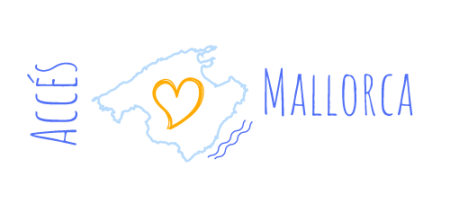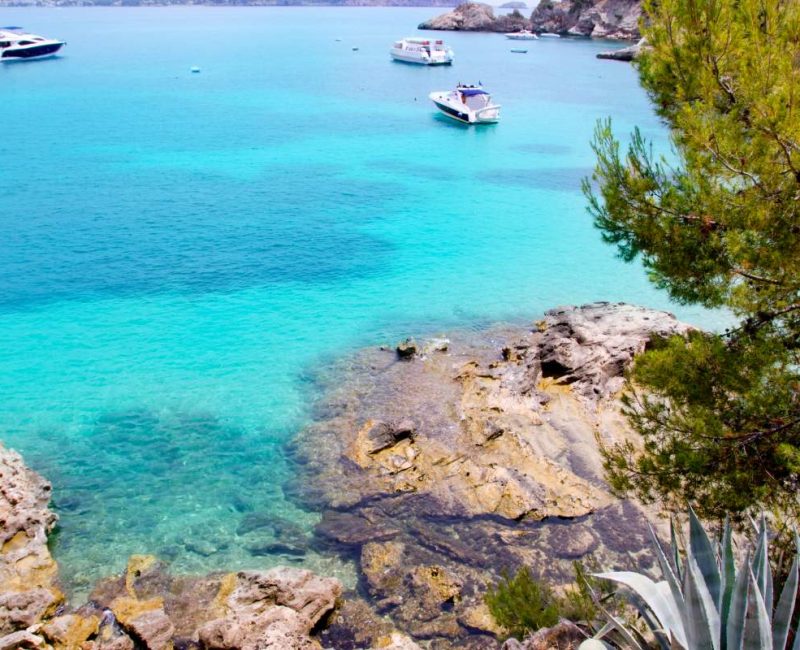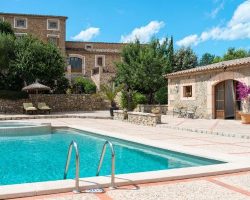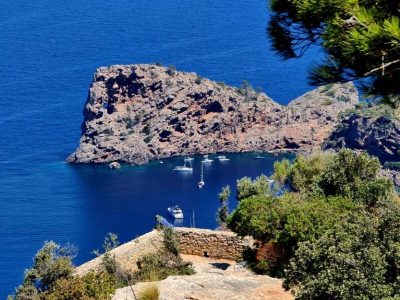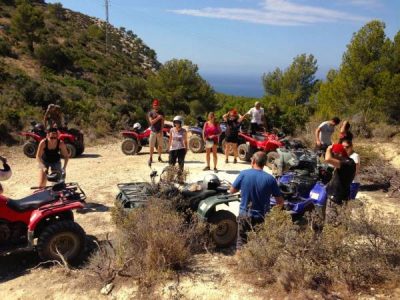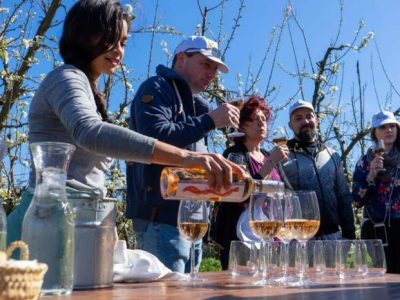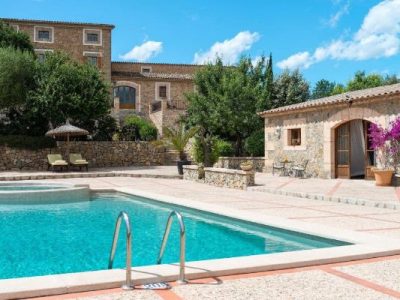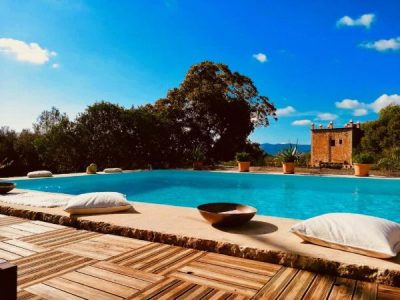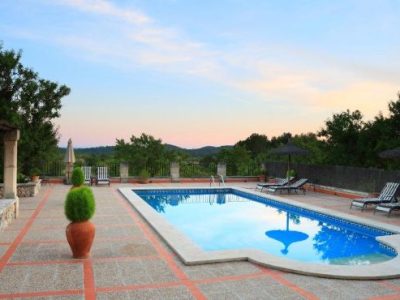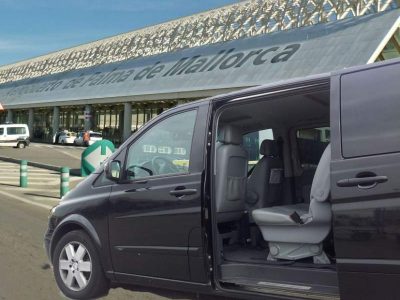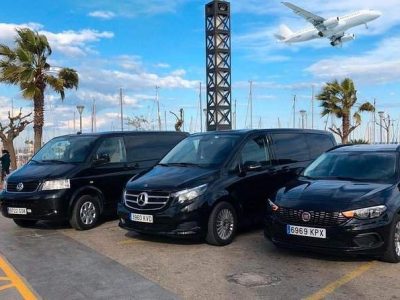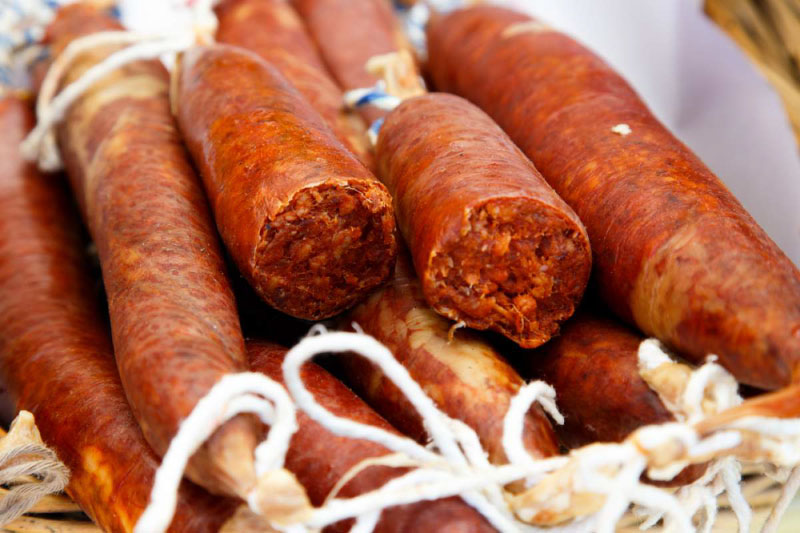However, we begin our journey back in time around 1,800 cal BC, in the Bronze Age. Two of the most remarkable discoveries done in Calvià are the ones of “Naveta Alemany”, found near the popular holiday destination of Magaluf, and the hypogeums of “Son Ferrer”, located between Magaluf and Santa Ponça. Both corresponds to a period on the island we know as the “pre-Talayotic” or “Naviform” (nave in Spanish), simply due to the fact that constructions were built in shape of a boat or elongated horseshoe. This period was from circa 1,800 cal BC to 1,500 cal BC.
The Son Ferrer hypogeums, or burial caves, was used up until the 2nd century BC. It is one of the best preserved and most interesting burial caves discovered in Mallorca and exhibits typical characteristics of its time of construction, with an elongated shape, a niche in the background and two banks separators on both sides. Inside the burial cave, human remains with clothes and funerary gifts was found. On top of the burial cave a mound has been constructed, presumably from around the late 2nd millennium BC or early 1st millennium BC, testifying to the continuous usage of these caves.
Findings of Punic ceramics also testify to the usage of these burial caves in later times, around the 5th, 4th and 3rd century BC. It is estimated that the Son Ferrer hypogeums date back to the 18th century cal BC due to the many findings and thorough excavation work done here.
Another significant discovery in this area is the Naveta d’Alemany site, presumably constructed around 1,700 BC / 1,600 BC. What is interesting about the Alemany site, is that is showcases the need to be able to scout the area and coastline, even though this meant that construction had to be done on an uneven surface. Supportive walls was built within the exterior and interior side walls to reinforce the construction where it was standing on uneven ground. Afterwards, the holes between the rocks of the walls were covered using olive wood, mud and small stones.
The Naveta d’Alemany was used for habitation and for decision making by the tribe leaders. A range of artifacts has been found at the site, including ceramics, pottery with floral motifs, a triangular bronze dagger, a stone mill and a baetylus (sacred stone). Moreover, multiple stone tools has been found such as punchers and spoons.
Other naviform constructions found in the municipality include the Son Boronat and Collet des Moro.
Somewhat between the late Bronze Age and the Iron Age, the Talayotic culture was introduced in Mallorca and Menorca. This culture came to leave its mark on the Balearics forever, with its unique multi-functional constructions that we know as “Talayots” or “Talaiots”. The name derives from the Catalan word “talaia” meaning watchtower. Talayots were circular or square megalithic constructions that could be up to about 22 meters in height and typically had a diameter of 10-15.
The Talayotic culture started appearing around 1,100 BC. It seems that around that time there was a change in the philosophy of how people lived and practiced everyday life on the islands. The Talayotic constructions mainly served two functions; to guard and to gather. The larger talayots were used as both scouting platforms and as focal points for the community where people would gather for various purposes. Some talayots were used solely for habitation of single families, these were typically smaller than the community talayots and located in less strategic places in the villages, which there were about 500 of in Mallorca by the time of the end of this era around the 6th century BC.
In Calvià, it is easy to understand and discover the Talayotic culture thanks to the excavations of the prehistoric village of Puig de sa Morisca. The first talayot in this area was erected around 850 BC, at the very summit of the hill allowing for the best views of the coastlines. The Puig de sa Morisca was actually used back from the late Bronze Age, but the village did not start to develop until the time of the Talayotic culture. One of the best preserved talayots is the Son Miralles found in the ancient village.
The main activities of the Talayotic people was agricultural and production of crafts. Agricultural activities revolved around livestock farming, which besides from meat, comprised secondary activities such as milk, cheese, wool and strength for pulling and dragging. Most manufacturing activities were limited to crafts for domestic use such as tools, ceramics, textiles etc. In other words, there was no manufacturing done for the purpose of trading.
At the social level, the Talayotic culture introduced more complexity with hierarchy in the society.
The construction of talayots ended around the 6th century BC, however, they remained occupied for many centuries to come. The phase which began from the 6th century is referred to the “Balearic” or “Post-Talayotic”, which lasted until the 2nd century BC when the Romans conquered the islands.
From around the 6th and 5th century BC, colonizers and tradesmen from Greece and Carthage started to arrive on the island giving the settlement of Puig de sa Morisca even more strategic importance. Particularly ancient Phoenicians came to be a big part of this period as they rapidly expanded their activities in the western Mediterranean.
Not only did the Phoenicians engage in trading, they also settled in many coastal areas around the western Mediterranean basin. Beside from the interest in trading activities, the Phoenicians were on a constant quest for minerals such as ore which was abundant in particularly the southern part of the Iberian peninsula. They had a predilection for islands and coastal areas because it allowed them to quickly move goods via naval routes. The island of Ibiza for example, was named by the Phoenicians who called it “Ebussa” meaning pine or covered in pine.
The many Phoenician settlements led to a mix with indigenous peoples as the case with Mallorca and, in Calvià, the village of Puig de sa Morisca. The village continued to expand during this Balearic period as Phoenicians settled and started up a commercial center comprising storage and manufacturing facilities. Next to the village of Puig de sa Morisca you will find the Turó de Ses Abelles, a Phoenician factory and trading center set up from this time. It was one of two known Phoenician factories in Mallorca, the other was the one of Na Guardis in ses Salines.
Excavations of Turó de Ses Abelles has given a clear picture of the many activities performed here, which included milling, baking, weaving, production of metallurgic crafts, storage of amphorae and, just as important, trading with both sailors and villages inland. The location also allowed for full control of the coastline.
Aside from commercial activities such as manufacturing and trading of goods, another interesting occurrence from this time is worth talking about, the Balearic foners. The Balearic foners, often times referred to as “slingers”, were warriors highly skilled in throwing slingshots. Legends tell of how these warriors were raised, not allowed to eat before they could shoot beads of bread hung in strings from branches on the trees. Apart from hunting and protecting, the foners offered their services as corsairs and became renown and feared all over the Mediterranean for their deadly skills. In the Sicilian wars, Hannibal the Great is cited for giving extra credit to these warriors in several battles, as well as ordering his troops to give them more protection.
The Roman period
The Roman period of the Balearic Islands marks the transition between prehistory and Anno Domini. In 123 BC, the Roman troops led by general Quintus Caecilius Metellus conquered the archipelago under the accusation of piracy, which awarded him a Roman Triumph, the title of censor and the cognomen Balearicus. Following the successful campaign, the two cities of Palma and Pol-lèntia was founded on the island, whereof the latter was the most important economical and political center of the islands.
The many old Talayotic settlements continued to coexist during Roman times on the island. The Romans introduced cultivation techniques to the islands which completed the Mediterranean triad; grains, grapes and olives.
Moreover, the Balearic foners (slingers) continued to serve under Roman power. Julius Caesar have mentioned them in his chronicles of the Gaul war, where they were part of the elite troops.
In Calvià, the site of Sa Mesquida (Santa Ponça) is the best evidence of the Roman occupation. It is located next to the Eroski supermarket by Av. Jaume I. Archaeological excavations has given a very clear picture of the small village that was here during the Roman period. Sa Mesquida consisted of a set of buildings surrounding a patio or courtyard with a well. An oven for producing ceramics has too been found here, which tells us of an agrarian community dedicated to production of agricultural and maritime products.
The Roman village of Sa Mesquida dates from the 1st century AD which makes it one of the oldest Roman settlements on the island. Moreover, Sa Mesquida was the first Roman village to be discovered when Seguí Rodriguez found ceramics back in 1886.
Excavations of Sa Mesquida has led to discoveries of many ceramics, cooking utensils, amphora, glassware, building materials, as well as fossilized feces and animal bones, all elements that testify to the daily life of the Roman village. Many of the ceramics found at Sa Mesquida has origin other places in the Mediterranean such as southern France, North Africa and the Iberian peninsula, which too proves the enormous maritime commerce of the ancient world.
Islamic rule
In 902-903, after centuries of isolation only interrupted by random raids and short stays by Vandals, Byzantines and pirates, the island was annexed to the Emirate of Cordóba. During a journey to Mecca in the late 9th century, Moorish nobleman Issam al-Khawlaní took shelter on the island during a storm. He returned to the island multiple times before he finally went to ask Emir Abdullah ibn Muhammad al-Umawi to ask him to capture the archipelago. Al-Khawlaní was given the honor to lead the campaign, as well as a fleet of ships and troops to assist him.
Following the successful campaign of al-Khawlaní, the archipelago was annexed to the Emirate of Cordóba under the name “Illes Orientals d’al-Àndalus”. Madīna Mayūrqa was founded, and not long after the city started to expand as the new Islamic population started to arrive. Public baths, mosques and water supplies were constructed, as well as the Almudaina palace which was the seat of the Moorish governor and the heart of the fortified urban core. Madīna Mayūrqa grew to become one of the most prosperous harbors in the Mediterranean basin based on trading and pirate activities.
The island was then divided in twelve administrative districts (ajzā) to make it easier to collect taxes. Calvià belonged to the Juz’ Ahwaz al-Madina, which comprised Madīna Mayūrqa, Andratx, Marratxi, the western areas of Esporles, Banyalbufar, Puigpunyent and Estellencs.
Within the district of Juz’ Ahwaz al-Madina, multiple farmsteads and cottages were established. Many of the new settlers came in kindred clans already well-organized, primarily of Berber tribes from present day Morocco. Many of these clans named their farmsteads after their clan name using the “Beni” or “Bini” prefix, which means “children of”. With this in mind, you can suddenly see many villages and places in Mallorca have Moorish origin. In the municipality of Calvià you can too find several places that still today carry their Moorish origin on the name, such as the Bendinat, Benimaharec, Beniorella, Benimoixet, Benicoraix, Benàtiga Vell. There are, however, also some that has been changed over the centuries but also derive from the Islamic time, namely Santa Ponça which used to be Sanat Bunsa, one of the biggest farmsteads in the area from that time. There is also those of Valldurgent, Son Boronat, Galatzo and Mofarés, the latter was situated where Calvià village is today.
The farmsteads was scattered all over the countryside, there was no such thing as delimitation of lands as we know it today, this concept was not introduced before feudal times post the conquest of 1229. The Moorish farmsteads, or alquerias, were located somewhat close to a water source. This fact brings us to another important highlight of the Islamic Mallorca, the hydraulic systems called “Quanats”. These quanats, were networks of pipes that transported the water from the stream to the land that was to be irrigated. By doing so, more farms could have access to the same water source, which was the main prerequisite for a farm to be established. Some of the most well-preserved hydraulic systems from the Moorish times in Calvià are those of Font des Obis, Font d’es Buscarrí, Font des Beat Ramón, Font de Benicoraix, Sa Font de sa Cometa, Sa Font Nova, Valldurgent, Font des Ratxo, Torre d’en Boira, Font de sa Cova, Font de sa Mola. Of water mills, the ones of Molí de sa Font de sa Mola, Molí de Son Martí, Molinos de Galatzó stand out.
The farms of Galatzó, Benicoraix, Mofarés, Valldurgent, Son Boronat, Benàtiga Vell and Sanat Bunsa all took water from the Santa Ponça aquifer, although from different collection points.
As a coastal area, the local farmsteads were particularly exposed to raids from the seaside. Four garrisons built inland functioned as refuges for the peasants in times of crisis; Sa Cova, S’Argolla, Puig des Caragol and Puig de Fàtima, all of them hidden in the rocky hills making them less visible from the coast.Some of the local farmsteads shared these lookouts, for example Benicoraix and Galatzó shared the s’Argolla, and Valldurgent and Benàtiga shared the Puig de Fàtima.
Moreover, as authors like Bazzana 1983 and Batet 2001 has pointed out, these hideouts were perfect for surveillance of the hydraulic systems. During Islamic rule of Mallorca, there was no governmental institution to control the distribution of water sources, it was up to the farmsteads and clans to balance this. Therefore, it would make great sense that some of these lookouts were actually functioning as a way to control the water. The Puig des Caragol controls the hydraulic systems of the Font des Ratxo and Sa Font de sa Cometa, that of S’Argolla that of the Font dels Obis, the Font des Tramuntanal and the Font des Buscarí, that of Sa Cova and the Puig de Fàtima pass, the Sa Font des Beat Ramon hydraulic complex.
On a final note in regards to Islamic or Moorish occupation of this area, it is worth mentioning the Puig de sa Morisca once again as a key point for controlling the coast. A wide range and variety of Moorish pottery has been found during excavations, especially household pottery and ceramics testifying to the domestic function of this place and not just as a military garrison. Storage tools such as jugs, kettles, ataifores (painted plates), jars with Moorish decorations such as bands and meanders has been found in plentiful amounts to give a clear picture of the functionality of the site.
The decorative techniques applied on these ceramics, sgraffito and dry rope and no animal motifs, corresponds to the final Islamic period, the Almohad period (1202-1229). Now, it can very well be that due to the turbulent environment of this time with wars and change in power that Puig de sa Morisca was serving as a refuge and military outpost. It was also here one of the first battles was fought when the Catalan-Aragonese troops disembarked during the conquest of Mallorca.
The conquest and late Middle Ages
One of the most defining years in the Mallorcan history is 1229, when King Jaume I of Aragón conquered the island from its Moorish rulers. Often times we simply refer to ‘the conquest’, as well as the time before and after when talking about historical highlights of the Middle Ages.
Calvià, and particularly Santa Ponça, is one of the most important places to mention from the time of the conquest, as it was here the troops of King Jaume disembarked when they arrived at the island in September, 1229, when the island was conquered by the Catalan-Aragonese king.
The original plan of King Jaume was to land in the bay of Pollença, but due to a storm the troops took shelter on the Dragonera and Pantaleu islands on Friday September 7, 1229. The stop allowed the troops to rest, gather strength and regroup.
Moorish lookouts on the coasts of Andratx spotted the troops of Jaume and quickly sent the message to the governor of the island. As the governor became aware of the imminent arrival of the Christian troops, he arranged a two divisions of a thousand cavalry each along with about 18,000 infantry to guard the coasts and occupy the possible landing sites. The Christian troops quickly left their position but was stalked by the Moorish soldiers who followed them along the coast. On Monday morning, September 10th, 1229, the Christian troops arrived at the beach of Santa Ponça after having left the Moorish followers behind.
The troops took advantage of the absence of Moorish soldiers in Santa Ponça, as the beach could be secured with only 500 men. A few ships carrying about 300 knights continued to the Sa Porrassa lagoon in Magaluf.
The first battle took place in the Puig de Morisca, when Lord Ramón de Montcada along with about 150 horsemen and 800 infantry seized the hill. The control of Santa Ponça and Puig de Morisca was vital to be able to organize properly and plan the next move, the march towards Medina Mayurqa.
Ramón de Montcada was in charge of leading the troops towards the capital, which began on Wednesday the 12th of September. On their way to the capital, the troops met a delegation of about 2,000 Moorish soldiers who had been sent to this position by the governor to repel the invasion.
